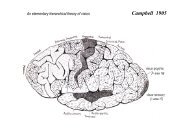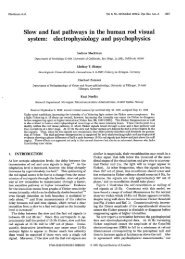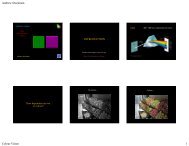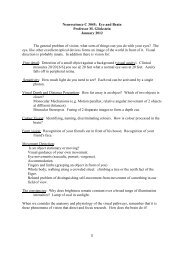Long-wavelength adaptation reveals slow ... - Journal of Vision
Long-wavelength adaptation reveals slow ... - Journal of Vision
Long-wavelength adaptation reveals slow ... - Journal of Vision
You also want an ePaper? Increase the reach of your titles
YUMPU automatically turns print PDFs into web optimized ePapers that Google loves.
<strong>Journal</strong> <strong>of</strong> <strong>Vision</strong> (2005) 5, 702–716 Stockman & Plummer 712frequency-dependent effects than we find here; Benardete& Kaplan, 1997; Derrington, Krauskopf, & Lennie, 1984;Lee, Martin, & Valberg, 1989; Lee, Pokorny, Smith, &Kremers, 1994; Smith et al., 1992). Such data point to aretinal source for the signal interactions that we identifypsychophysically. We should, however, be cautious aboutmaking overly simple connections between retinal physiologyand human psychophysics, because any signalsfound in the retina are likely to be modified by multiplestages before guiding the observer’s response in any psychophysicaltask. Nevertheless, the recent report that PCsignals can be identified in the responses <strong>of</strong> MC cells bySun and Lee (2004) lends support to the idea that theseinteractions might be occurring as early as the retina.A cortical origin for the signal interactions is also astrong possibility. The substantial delay between the <strong>slow</strong>and fast signals might arise because <strong>of</strong> differences in thetransmission times <strong>of</strong> parvocellular and magnocellularsignals to the cortex, where the two signals might then interactto generate an achromatic flicker signal. Indeed, theparvocellular system is delayed by on average 17 msrelative to the magnocellular system at the level <strong>of</strong> theLGN (e.g., Schmolesky et al., 1998), although other estimatesat the LGN or cortex are lower at about 10 ms (e.g.,Maunsell et al., 1999; Maunsell & Gibson, 1992). Thesedelays are comparable to the delays between the <strong>slow</strong> andfast signals that we find after correction for selectivereceptoral <strong>adaptation</strong> (see Figure 7 <strong>of</strong> Stockman & Plummer,2005). There is also plenty <strong>of</strong> evidence for color-luminanceinteractions in a sizeable fraction <strong>of</strong> cells in primary cortex(e.g., Conway, 2001; Cottaris & De Valois, 1998; Gouras,1974; Hubel & Wiesel, 1968; Lennie, Krauskopf, &Sclar, 1990; Vidyasagar, Kulikowski, Lipnicki, & Dreher,2002). In a recent, carefully controlled study <strong>of</strong> cone inputsto macaque V1, Johnson, Hawken, and Shapley (2004)classified 34% <strong>of</strong> cells as color-luminance cells, 10% ascolor-preferring cells, and 56% as luminance-preferringcells. Yet another possible route for the <strong>slow</strong> color signalsto interact with flicker (or motion) signals is suggestedby the recent finding <strong>of</strong> a direct geniculate inputfrom mostly koniocellular LGN neurons to MT (Sincich,Park, Wohlgemuth, & Horton, 2004).Wherever these signal interactions originate, their phaseand amplitude characteristics are distinctive enough thatthey should be unmistakable in physiological recordingsmade with the appropriate stimuliVassuming, that is, thatthe interaction can be measured in a single neurons (ratherthan in a network).Are very high intensity red fields effectivelygreen after the photoreceptors?The <strong>slow</strong>, spectrally opponent +sM sL signals thatprevail under conditions <strong>of</strong> very intense long-<strong>wavelength</strong><strong>adaptation</strong> also prevail on adapting fields <strong>of</strong> <strong>wavelength</strong>sshorter than c. 570 nm (Stockman & Plummer, personalcommunication; Stromeyer et al., 1997). But why shouldan intense long-<strong>wavelength</strong> field and a short or middle<strong>wavelength</strong>field both reveal the same postreceptoralsignals? Intensity-dependent changes in color appearance,which are known collectively as the BezoldYBrücke effect,are well documented. Purdy (1931), in a fairly extensivestudy, reported that the appearance <strong>of</strong> long-<strong>wavelength</strong>lights shifted from red towards yellow with increasingradiance, but no further; there being an invariant <strong>wavelength</strong>at about 575 at which no change in apparent colorwith radiance was found. This observation is consistentwith first-order kinetics, which predicts that the asymptoticsensitivity <strong>of</strong> a cone at high bleaching levels shouldbe limited by Weber’s Law. Thus, although intense long<strong>wavelength</strong>bleaching lights would be expected to becomepostreceptorally neutral at high intensities (becausethe two cone types become equally sensitive to the background;see also above), they would not be expected to havean effect comparable to a short- or middle-<strong>wavelength</strong> light.Purdy’s observations, however, were made on onlymoderate to high intensity long-<strong>wavelength</strong> fields. At veryhigh intensities, the apparent color <strong>of</strong> a long-<strong>wavelength</strong>field gradually changes from red to yellow and finallyto green, which remains the Bsteady-state[ appearance(Auerbach & Wald, 1955; Cornsweet, Fowler, Rabedeau,Whalen, & Williams, 1958). Indeed, we also observe thatvery intense long-<strong>wavelength</strong> backgrounds (above thetransition from +sL sM to sL+sM) obtain a green tingeunder steady-state conditions. Interestingly, Cornsweet(1962) later contradicted his earlier conclusions (whichwere inconsistent with a first-order model <strong>of</strong> kinetics) andreported that the green appearance eventually faded backto yellow. We do not observe such a change on ourbrightest 658-nm fields.For long-<strong>wavelength</strong> fields to become effectively greenafter the photoreceptors, the additional loss <strong>of</strong> sensitivityin the L-cones to the background caused by bleaching hasto exceed Weber’s Law before the loss <strong>of</strong> sensitivity inthe M-cones reaches the same level. There is, in fact,good evidence that the L-cone loss will exceed that <strong>of</strong>the M-cone, because, although first-order bleaching kineticsis a useful simplification, the kinetics are, nonlinear.Several studies now concur that bleaching actually fallsbelow the first-order prediction at low bleaching levelsand above it at high (e.g., Burns & Elsner, 1985, 1989;Mahroo & Lamb, 2004; Reeves, Wu, & Schirillo, 1998;Smith, Pokorny, & van Norren, 1983). See, in particular,Figure 11B and Equation A10 <strong>of</strong> Mahroo & Lamb (2004);and for a general discussion, see Lamb & Pugh (2004). Theadditional loss <strong>of</strong> L-cone sensitivity to the backgroundcaused by nonlinear kinetics at high bleaching levels couldbe sufficient to make a high intensity long-<strong>wavelength</strong>bleaching field act postreceptorally more like a short- ormiddle-<strong>wavelength</strong> field.We speculate that the critical long-<strong>wavelength</strong> backgroundradiance is equivalent to a physiologically Bneutral[










